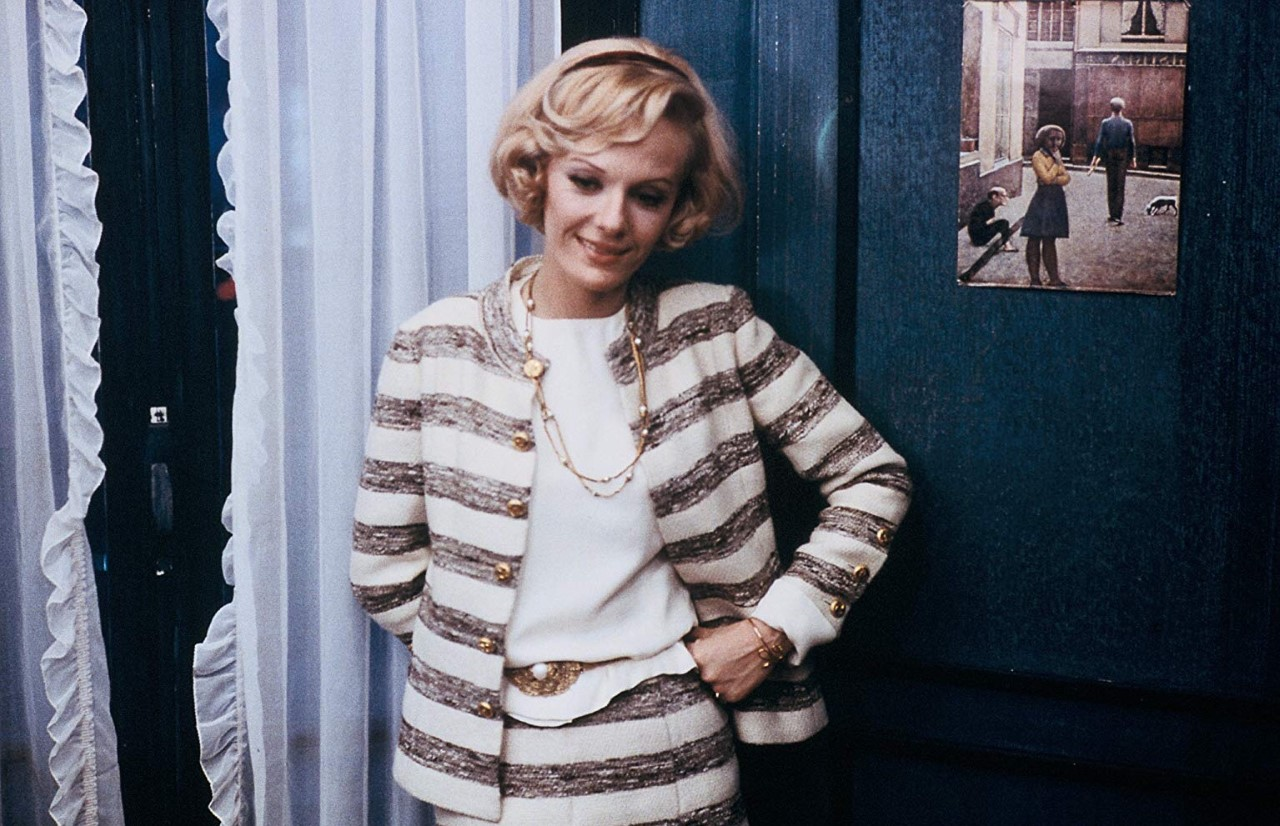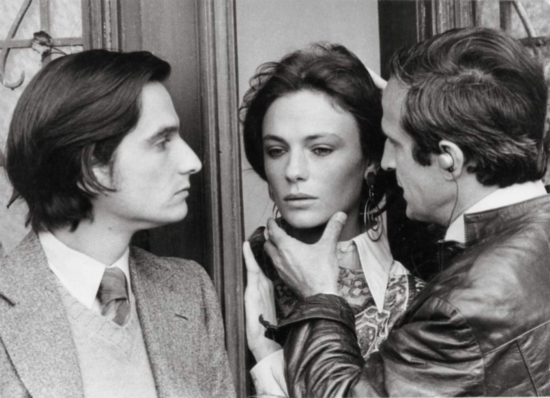
Cinema is a woman’s art, François Truffaut used to say, and the great moments in cinema involve “the convergence of the gifts of a director and those of an actress who is being directed by him.” In his films, it’s his feminine characters who are more dynamic, more enterprising, it’s them who direct events. It’s them he wants to get close to and his close-ups, much more often than when filming men, show that. Even in Tirez sur le pianiste, the two gangsters who kidnap Charlie (Charles Aznavour) talk only about women. One of them even says that his father died in a car accident because “he turned his head after every woman (…) one of them must have had her skirt too short, he didn’t take his eyes off of her and was run over by a car.” And just like that, we are introduced to the precursor of Charles Denner in L’Homme qui aimait les femmes. The male characters in François Truffaut’s movies, just like Truffaut, love women. In his films, he avoided political or social concerns to focus on love and relationships, many times concentrating on character rather than plot and stimulating interest through suspense. Love was the subject of subjects for Truffaut, but it had to have something distinctive about it, never involving general consensus, never packed with artificial problems. An ardent Alfred Hitchcock admirer, Truffaut regularly played with the suspense repertoire, but parted company with Hitchcock in key moments, because François Truffaut’s cinema and style are all his own.
“I was attracted to his world, I think, a world in which women figure importantly usually,” Jacqueline Bisset, who starred in La nuit américaine, told Film Talk. “They are important in his stories and as a woman you feel that. Children are also important, so you feel the sensitivity. His dialogues are so marvellous, so fresh, so personal, cynical at times, all kinds of points of view, even if you look at Jules et Jim [1962] today, you can still recognize all of that. When I was a child I didn’t have lots of media, so when I saw one of his films I let it sit in my mind, it filled a large space with things I didn’t know about. I don’t know picking on any film nowadays when there’s so much media – it just bombards you, whether you can pick up things in the same way.” It is the magic of cinema that Truffaut believed in and made us believe in it, too, even when he made a film about making films, La nuit américaine, seemingly peeling away layers of acting and craft. Much of the mystery and fascination remains. Just as the recurrent question in his films: “Are women magic?” He regularly, eloquently demythologizes this idea, and, still, he goes back to it in almost every movie. The fascination is permanent and vital.
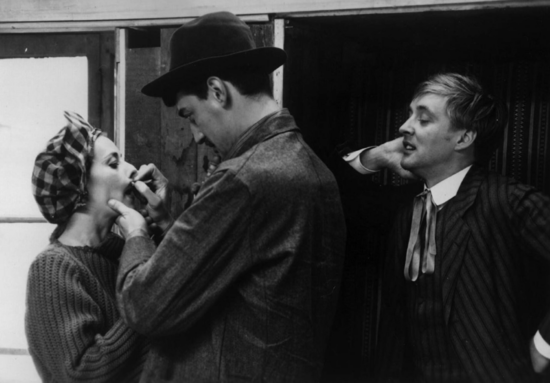
Jeanne Moreau (Catherine) in Jules et Jim, 1962
In Jules et Jim, Truffaut wanted to depict something films had never done before: showing a woman who loves two men simultaneously, all her life. And he wanted to do it in a way in which he would keep the film from being typecast into an existing film style. Which he did with exceptional flair: calling it a love triangle would not be quite accurate, because there is a true friendship among the three of them, such freshness, simplicity and naturalness, and the feeling of the eternal present in the relationship of Jules and Jim and Catherine, somehow “the ideal image of romantic life, minus the cruelty brought about by the desire of possession that leads to jealousy”, as Jeanne Moreau explained in a comment about the film. You don’t judge Catherine and you don’t take any sides, because as Jim says to Jules, “she is an apparition for all men, but perhaps not a woman one can have for oneself.” Catherine does not cheat on anyone, she is free and open, but she is ready to punish anyone who lies.
“I believe, just like you do, that in love, the couple is not the ideal formula. You wanted to build something better, refusing hypocrisy, you wanted to invent love. But pioneers have to be humble and selfishless. No, you have to face it, Catherine, we have failed,” says Jim. Catherine is one of those Truffaut heroines who don’t like to be read or judged. Truffaut said that the character “wants to live in the same manner as a man, but that is only a particularity of her personality, and doesn’t represent a feminist attitude or a form of protest.” In fact, Truffaut later admitted that he would have been embarrassed to have made Jules et Jim during the time of the Women’s Liberation Movement. He said he would have been troubled by the similarities that have occurred between his story, in which a woman is queen, and the actions promoted at present by the MLF. Long gone are the days of pure, independent cinema, freed of social and political factors.
Catherine is admired, not loved. Truffaut didn’t seek popularity with his characters. But his film depends heavily on the luminous femininity of Jeanne Moreau, as her character Catherine embarks on a dangerous liaison with bohemian best friends Jules and Jim (Oskar Werner and Henri Serre). Inquisitive, spontaneous, iconoclastic and capricious, the free-spirited Moreau refuses to be understood and she slips between affection and cruelty in her bid to live for a moment forever on the verge of being snatched away. “Her qualities as an actress and as a woman made Catherine real before our eyes, made her plausible, crazy, possessive, passionate, but above all, adorable,” said the director about Jean Moreau.
Catherine is intensely feminine and sexually provocative even when she disguises herself as Thomas, surprising herself too of how she gets away with wearing men’s clothes and a mustache in a scene of shared dandyism. It was the character’s tomboy fashion that became iconic. The French New Wave invented a whole new cinema style, from experimenting with new film form, to costume approach, embracing an openness to seize whatever happened during filming and using it in the film. As Jeanne Moreau said in an interview, “I was at that age where one lives very egocentrically; I saw it as the chance of a lifetime a chance to escape the ‘star’ style… all of a sudden we were filming in the street with very little makeup, costumes you found yourself. No one was telling me anymore ‘you have circles under your eyes, your face is lopsided’, suddenly it was life.” A lot of the clothes Catherine is wearing in the film, especially the modern clothes she wears after the war (the oversized cardigans and striped sweaters – there are stripes of every kind in Catherine’s wardrobe: from mariniere tops to a single stripe detail around the neckline or sleeve edges of a sweater -, the pleated skirts, the suede mid-calf boots, the espadrilles, the preppy checkered skirts and ties with white shirts, the newsboy cap), belonged to Jeanne. It’s so effortless, but let’s not forget that the dandy woman loves showing off her most hidden feminine side. It’s the male/female puzzle that so much fascinated in those days as it does today.
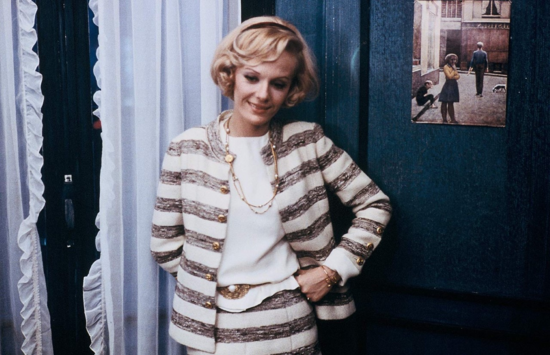
Delphine Seyrig (Fabienne Tabard) in Baisers volés, 1968
“I was thinking of Delphine Seyrig for Baisers volés. The role was written for her. […] Part of the role depended upon the glamour she had gained from her role in L’Année dernière à Marienbad; my film had to have an actress who had made that earlier film – it couldn’t be anyone else.” In Alain Resnais’ film, Delphine is wearing Chanel and the baroque decors (the filming took place at two castles outside of Munich, Nymphenburg and Amalienburg) served as an impressive frame for the elegance and exactitude of Chanel’s dresses. Delphine’s wardrobe is so sophisticated, yet so light in details: layers of tulle, wisps of chiffon, delicate lace and dramatic feathers (those sensational white feathery peignoir and black cape), as if especially created to drift unnoticed through the sumptuous corridors and gilded rooms and the architectural, majestic gardens in Resnais’ unconventional movie.
Baisers volés (Stolen Kisses) is about learning to love, shot with a comical and melancholy tone, with enough acting improvisation which reinforced the unpredictable quality of the scenes. We meet Delphine’s Fabienne Tabard as she enters in the middle of the night the shoe store where Antoine Doinel works because she is in the mood for a pair of Chanel shoes. She wears Chanel, naturally, throughout the film, just as she has in Last Year at Marienbad. And that’s how Doinel discovers this glamorous dream apparition, a graceful silhouette in a black dress wrapped in a white fur and trying on a shoe. She presents herself as Mrs. Tabard, the owner’s wife. The inaccessibility occurs. But Truffaut wants to demythologize the concept of “magical woman”. Antoine places her on a pedestal, and when he is invited to her house for lunch, he gets uncomfortable and spills a cup of coffee and runs away, as he always does when he is uncomfortable. But she steps down from that pedestal, goes to his house and joins him in bed. “I am not an apparition, I am a woman. […] For example, this morning, before coming here, I dressed up, I powdered my nose… I made up my eyes and .. crossing Paris, I realised all women do the same thing, for their own pleasure or out of politeness… You say I am exceptional. That’s right, I am, all women are exceptional, everyone in their own way, you are exceptional, too… Your fingerprints are unique… Do you know that? You are unique. We both are unique, unique and irreplaceable.”
Truffaut admitted he cast Seyrig on account of her reputation, but in a comic way, something she had never attempted but was perfectly capable of delivering. It is the Léaud-Seyrig couple that makes one laugh, because there is indeed an enormous contrast between her and him. And yet… “Moments in which one shouldn’t be afraid to linger – like Delphine Seyrig in Jean-Pierre Léaud’s bedroom, for instance. She can take her time, allow silences to occur – I know that we are going to listen to her.” And we do, because she speaks a tough and profound truth, but which Truffaut had the skill to present as lighthearted.
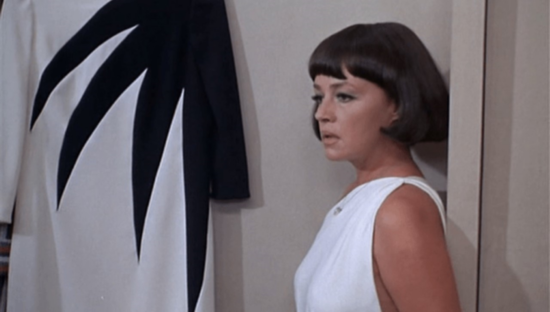
Jeanne Moreau (Julie Kohler) in La mariée était en noir, 1968
Having declined Mike Nichol’s invitation to play Mrs. Robinson in The Graduate (1967), Jeanne Moreau reunited with François Truffaut in this homage to Alfred Hitchcock. Moreau, as Julie Kohler, a widow wreaking vengeance on the five men linked to the killing of her husband on their wedding day, eschews tragedy and takes Truffaut’s advice to play the character “like a skilled worker with a job to do, conscientious and obstinate”. Moreau impressed Hitchcock with her performance, who wished she had given poison victim Coral (Michel Bouquet) a pillow “so that he could die with more comfort”.
“The Bride Wore Black is actually a film about love that is grounded in a pure feeling, because, for Julie, it involves a love from the past. She herself, on the screen, incarnates a kind of living death. She lives on after her husband only for the sake of avenging him,” Truffaut explained. “I stayed awake at night counting the minutes and seconds that separated me from the moment when I would see him again,” is Julie Kohler’s final confession.
There is no emotion, no guilt in her, and you are not appalled by her actions, because they are part of a necessary plan. And nothing deters her from her goal. Truffaut wanted no artifice, he wanted Jeanne to play the role simply, in a manner that would render her actions believable and human. “No laugh, no smile, no sulking, no bitter expression. I wanted her face to be neither open, nor closed, but normal, determined. I asked her to act without any flirtations, like a man, a man who is thinking about a job he needs to get done. I wanted Jeanne Moreau to remind one less of a goddess of revenge than of someone who is purposeful and efficient. I asked her to act like a skilled craftsman.”
Throughout the film, despite the title, The Bride Wore Black, Julie wears black as well as white (her costumes were fashioned by her ex-lover Pierre Cardin), and Truffaut explained that by dressing her only in black and white in a colour film, she gave the impression that “rather than entering into the setting or leaving from it, one would say that she simply appears or disappears.” We never see her arrive or leave. She is like an apparition, but her presence is less dreamlike and more shocking, foreseeing the worst. White as a validation of her absolute motives, black as a testimony of her preordained fate rather than a punishment for her actions. This duality comes in full play in the sequence where she comes after Fergus (Charles Denner), her fifth victim. He is an artist and she goes to his studio to pose for him as his model. He asks her to dress as Diana the Huntress, in a white dress, with a bow and arrow. Goddess? Huntress? Both. But dressed like that, she’s only playing a role. She doesn’t need a disguise, because she has come dressed in a white dress with a black pattern resembling a grabbing fateful hand (image above).
This piece is published courtesy of classiq.me
Editorial sources: Truffaut on Cinema, compiled by Anne Gillain / François Truffaut at Work, by Carole Le Berre / François Truffaut, bãrbatul care iubea filmele, by Magda Mihãilescu / François Truffaut: The Complete Films, by Robert Ingram / The Films in My Life, by François Truffaut / Yves Saint Laurent, published by Foundation Pierre Bergé Yves Saint Laurent / audio commentaries with Serge Toubiana, Fanny Ardant, Gérard Depardieu and Véronique Silver on The François Truffaut Collection and The Adventures of Antoine Doinel, released by Artificial Eye / interview with Jacqueline Bisset for Film Talk
